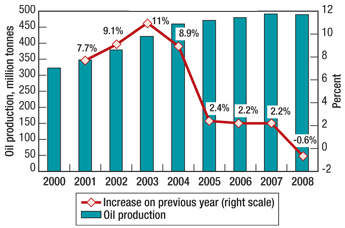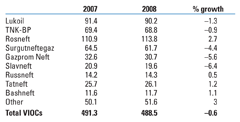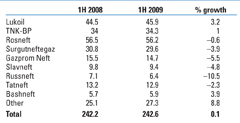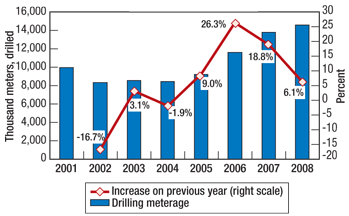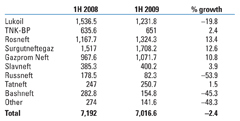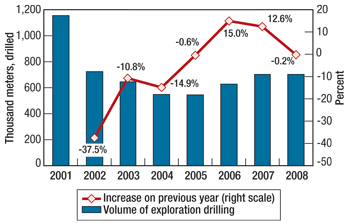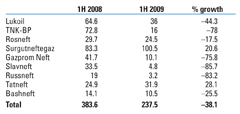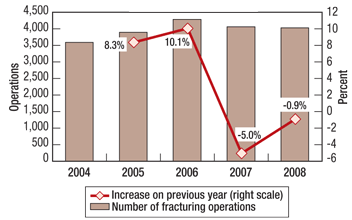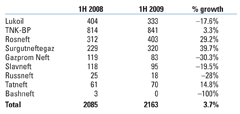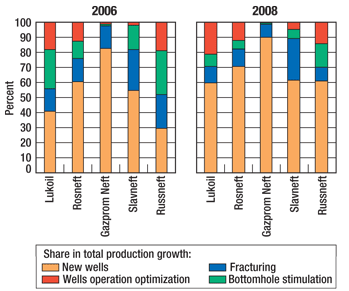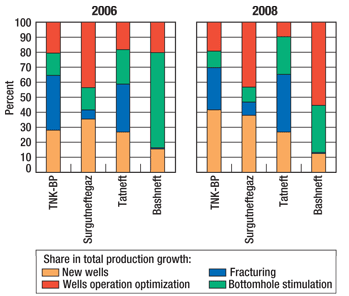Russia’s drilling rates will remain high; oil production will not drop substantially
Russian oil companies managed to maintain production volumes in the first half of 2009 comparable with the same period in 2008.
Russian oil companies managed to maintain production volumes in the first half of 2009 comparable with the same period in 2008.Maxim Matuk, RPI, Moscow Despite the overall favorable pricing environment in 2008, the Russian oil production and oilfield services sector has still failed to reverse the trends of the past two to three years. Cumulative oil and gas condensate production in Russia over the past three years has grown a little more than 2% annually, finishing the year at 488.5 million tonnes per annum (mtpa), a decrease of 2.8 million tonnes from 2007, Fig. 1. Oil production companies were involved in large-scale investments to acquire various assets in Russia and abroad, while paying less attention to the exploration and development of new oil fields and deposits. These factors affected conditions in 2008, when newly commissioned oil projects could not compensate for production losses in the main oil fields.
2008 PRODUCTION Several Russian vertically integrated oil companies (VIOCs) reduced their oil production volumes in 2008. According to year-end results, Lukoil produced 1.2 million tonnes less than in 2007; TNK-BP cut its production by 0.6 million tonnes; Surgutneftegaz cut production by 2.8 million tonnes; and Gazprom Neft cut production by 1.8 million tonnes, Table 1. A substantial drop in the aggregate extraction in 2008 was avoided due to production increases by Rosneft (by 3 million tonnes) and independent oil companies, whose aggregate oil production volume in 2008 went up by 1.9 million tonnes over 2007. The largest volumes extracted by independent producers were attributable to Gazprom divisions, production sharing agreement (PSA) operators in Sakhalin (around 12 million tonnes) and Salym Petroleum Development (6.3 million tonnes, with 48.6% production growth compared to 2007).
The following factors have contributed to the decline in oil production in 2008: Apart from industry-specific factors, the decline in oil production can also be attributed to certain oil producer business development issues. Lukoil was unable to compensate for decreasing oil production at the main oil fields in Khanty-Mansiysk Autonomous District (Tevlinsko-Russkinskoye, Vat Yeganskoye and Povhovskoye Fields), even with increased production achieved on its new projects—Yuzhno-Khylchuyuskoe, Kharyaga and Pashorskoe Fields. TNK-BP extracts 40% of its oil production volume at the mature Samotlorskoye oil field, while the company’s new projects (the Uvat group of fields, the Verkhnechonskoye and Russkoe oil fields) are currently at the initial stage of development, and flowrates in these fields have been insufficient to offset lower production in old oil regions. Gazprom Neft produces around 60% of its total volume from the Yamalo-Nenetsky Autonomous District oil fields, which show declining production (Sugmut Field, etc.). Surgutneftegaz’s key deposits in Western Siberia have already passed their peak oil rate, and the volumes of oil extracted at the new oil fields of Eastern Siberia are not sufficient to reverse the decreasing tendency. Moreover, the company has already planned an oil production decrease for 2009, since its focus this year is on establishing new oil production centers in Eastern Siberia and Timan-Pechora (Nenets Autonomous District). The production growth achieved by Rosneft was driven almost entirely by an increase in oil production at Yuganskneftegaz’s oil fields (Western Siberian subsidiary, formerly owned by Yukos). 2009 PRODUCTION In spite of the global financial crisis, Russian oil companies managed to maintain production volumes in the first half of 2009 compared with the same period in 2008, Table 2. It is worth mentioning, though, that positive growth in oil production was achieved only by Lukoil (almost 1.5 million tonnes due to startup of the Yuzhno-Khylchuyuskoe oil field), TNK-BP (0.3 million tonnes), Bashneft (0.2 million tonnes) and independent companies. Out of the total volume increase by the independent producers (2.3 million tonnes), nearly 1 million tonnes is attributable to Salym Petroleum Development.
For 2009, and in the years to come, Lukoil’s key business objectives are: to complete the current exploration program; to bring Pyakyakhinskoye Field onstream; to increase annual production in Yuzhno-Khilchuyuskoye Field to 7.5 mtpa; to develop new Caspian offshore fields; and to develop Yury Korchagin Field. Rosneft’s short-term focus is on the Vankor project. TNK-BP is looking for production growth from Verkhnechonskoye Field in Irkutsk Region (brought onstream in the autumn of 2008), the Uvat project (where production started in February 2009) and the northern part of Kamennoye Field in Khanty-Mansiysk Autonomous District (where commercial development started in June 2009). In 2009, oil production in Kamennoye Field could reach 1.8 million tonnes, which is 40% higher than in the previous year, while output from Uvatskoye Field may grow as high as 2.7 million tonnes. During the next few years, Gazprom Neft expects to increase production in Russia due to the development of Yuzhno-Priobskoye Field and the 16.95% of Sibir Energy assets that Gazprom Neft acquired this year. In 2009 and 2010, Surgutneftegaz is planning to begin development in five fields. One of those, Alinskoye Field in Eastern Siberia, will allow the company to boost its output in the region to 1.9 million tonnes. Surgutneftegaz’s growing production drilling will reflect positively on production rates over the next few years as output steadies and then gradually increases. The upward trend will also be supported by bringing Talakanskoye Field in Eastern Siberia to its design flowrate. PRODUCTION DRILLING Despite the introduction of more sophisticated methods of oilfield stimulation, drilling of new production wells has remained the most effective way of increasing oil production volumes in Russia in the last few years. This is the main reason for the constant growth of production drilling meterage in Russia since 2005, Fig. 2. In 2008, production drilling meterage reached a record figure of 14.6 million m. However, most drilling was performed in old oil areas and did not result in higher oil flowrates. The biggest drilling volumes in 2008 in Russia fell with Surgutneftegaz (over 3.1 million m), Lukoil (around 3 million m) and Rosneft (almost 2.5 million m), which equaled almost 60% of Russia’s drilling. It should also be noted that the Gazprom Neft companies increased their drilling volumes almost threefold over a four-year period, from 0.7 million m in 2005 to 2 million m in 2008.
Lukoil concentrated its production drilling efforts in Western Siberia (Nivagalskoye and Kechimovskoye Fields) and Timan-Pechora (Kharyaginskoye, Pashshorskoye, Yuzhno-Khilchuyuskoye and Kyrtayelskoye Fields). Rosneft performed most of its production drilling in three regions: Khanty-Mansiysk Autonomous District (Priobskoye Field), Tomsk region (Pervomayskoye, Krapivinskoye and Igolno-Talovoye Fields) and Eastern Siberia (Vankorskoye, Verkhnechonskoye and Yurubcheno-Takhomskoye Fields). Surgutneftegaz is planning to start development in five fields in 2009: Alinskoye Field in Eastern Siberia and Vostochno-Mytayakhinskoye, Severo-Tutlimskoye, Ovlikhlorskoye and Zhumazhanovskoye Fields in Western Siberia. Rogozhnikovskoye Field, the company’s most recent field, is also expected to increase production. Gazprom Neft is intending to increase production in three areas: the left-bank area of Priobskoye Field in the Khanty-Mansiysk Autonomous District, Krapivinskoye, Shinginskoye and Archinskoye Fields in the Tomsk and Omsk regions, and the Sugmutskoye Field in the Yamal-Nenets Autonomous District. TNK-BP’s plans are to maintain current production rates in Samotlor Field because of new oil discoveries in satellite structures. However, the company’s major investments in production drilling will be in the Uvat group of fields as well as in Kamennoye and Verkhnechonskoye fields. Comparison of production drilling in the first halves of 2008 and 2009 demonstrates that there has been no material decrease in drilling volumes in 2009 compared to the successful previous year, Table 3. Furthermore, many VIOCs increased drilling volumes. The biggest growth was observed with Rosneft (156,500 m or 13.4%) and Surgutneftegaz (191,200 m or 12.6%). Considerable growth of Rosneft’s drilling meterage (over 80,000 m) fell within the company’s Vankor project. Lukoil demonstrated a drilling decrease (305,000 m or 20%), which was caused by the reduction of the company’s low-profitability projects in the Khanty-Mansiysk Autonomous District and considerable drilling in 2008 when preparing the Yuzhno-Khylchuyusk Field for commissioning. The following companies drastically reduced drilling volumes in the first half of 2009: Rusneft (96,000 m or 54%), Bashneft (128,000 m or 45%) and independent companies (132,400 m or 48%).
The decrease in production drilling in the first half of 2009 happened mostly during the first quarter as a reaction to the economic crisis. During this period, oil companies followed pessimistic scenarios of development strategies, which presupposed maximum cost savings. However, already in Q2, 2009, the companies had defined their development directions and drilling in Russia grew by 19.4% to 3.8 million m compared to Q1. All Russian VIOCs, except for Bashneft, Tatneft and Russneft, more or less increased production drilling. EXPLORATION DRILLING After a considerable decline of exploration drilling in 2004–2005, the annual drilling meterage of all Russian VIOCs grew, and in 2007 and 2008 settled at the level of 700,000–705,000 m, Fig. 3. The lion’s share of exploration drilling went to Surgutneftegaz (169,200 m in 2008), Lukoil (118,900 m), TNK-BP (114,900 m), Gazprom Neft (67,800 m) and Tatneft (62,000 m). The drilling meterage of Surgutneftegaz is stable and high. However, since 2002 it has been constantly decreasing; over this period the company’s annual exploration drilling meterage dropped by 40%. However, Surgutneftegaz still has to perform exploration drilling both at its old areas in Western Siberia and at the new fields in Eastern Siberia. The majority of Lukoil’s exploration drilling (around 52%) is performed in Western Siberia. At the end of 2008, 39% of the TNK-BP exploration drilling meterage fell within the Uvat project and 36% within the fields of the Orenburg region. Tatneft produced one-fifth of its exploration drilling in 2008 in the Samara region.
In the first half of 2009, almost all Russian VIOCs, except Surgutneftegaz and Tatneft, reduced their exploration drilling volumes. Due to the difficult financial situation in 2008 and early 2009, when making their short-term financial and economic plans and in order to cut costs, oil companies reduced those types of work that would not generate short-term profit, Table 4.
FRACTURING Today, fracturing operations account for more of the growth in output than does any other production stimulation method, Fig. 4. Russian oil producers started using fracturing more intensively in 2004, before which the number of annual frac jobs was much smaller. This recovery method has become quite popular among Russian oil companies for achieving higher flowrates at low capital costs. In 2007 and 2008, the volume of fracturing operations carried out by the Russian VIOCs constituted 4,000 operations per year. In 2008, TNK-BP accounted for the greatest number of fracturing operations (more than 1,500 operations or 40% of the total number of fracturing operations performed that year in the Russian Federation). As a rule, the company pays great attention to this well stimulation technique, as before 2008, fracturing operations accounted for the biggest share in the TNK-BP total volume of production buildup (i.e., the share of oil produced after fracturing was greater than that produced as a result of drilling new wells). In 2008, Lukoil, Rosneft and Surgutneftegaz accounted for over 47% of all fracturing operations in Russia. From 2007 to 2008, Lukoil and Surgutneftegaz increased their share of fracturing operations by 2.3% and 21.2%, respectively. In contrast, Rosneft’s volume of frac jobs went down by 15.7% during the same period. In 2008, more than 80% of the fracturing operations performed by these companies were in Western Siberia.
In spite of the crisis, the number of fracturing operations performed by the Russian VIOCs in the first half of 2009 has not declined; moreover, this number has grown 3.75% compared to H1 2008, Table 5. In early 2009, the companies used all the tools they had at their disposal to increase production, so fracturing, which results in a substantial increase in the flow, became even more popular. Only Lukoil reduced the number of fracturing operations in the first half of 2009 (by 17.6% compared to H1 2008), but at the same time, the company managed to increase the production by commissioning new oil fields in Timan-Pechora. A substantial reduction of fracturing operations was observed in the oil fields of Western Siberia. TNK-BP accounted for the greatest number of operations; at the same time, half of all fracturing operations were carried out in the oil fields operated by its subsidiary Samotlorneftegaz.
Russian VIOCs are known to apply all methods that ensure production growth (including both enhanced recovery and new drilling), but their efficiency varies from company to company. In fact, these companies can be divided into two distinct groups depending on how much oil they produce and how many new wells they bring onstream using primary stimulation methods. Group One comprises companies that achieve production growth by bringing new wells onstream, Fig. 5. Over the past three years, these companies have reported sustained production growth. Gazprom Neft has attributed most of its production growth to new wells, with only slightly over 10% of its annual production growth in 2008 attributable to various stimulation methods.
Group Two includes companies that increase their production rates using various bottomhole stimulation operations, Fig. 6. These companies indicate production growth through stimulation methods rather than the drilling of new wells, though the amount of oil produced as the result of different stimulation operations may change from company to company. In contrast to Group One, the share of intensification methods in total annual production growth has not increased for the past three years.
CONCLUSIONS Based on the results of the first six months of 2009, oil production in Russia will not drop substantially for the year. If current production conditions and volumes are maintained, total production for 2009 will remain at 2008 levels, with a chance to improve by 0.5–1% under favorable conditions. Production drilling rates will remain high (both in 2009 and 2010). New wells still remain the major production growth driver for Russian oil producers, both in old and new fields. When new, more complicated fields are developed, oil producers will step up their use of state-of-the-art, high-tech servicing operations that will strengthen the positions of Western companies (the technology owners). Intensive use of fracturing by Russian VIOCs will gradually reduce the efficiency of the method. Nevertheless, oil producers will keep performing fracturing operations in 2009 and 2010 nearly as much as in 2008. Over the past few years, Russian VIOCs have developed certain approaches toward different servicing operations that enable them to increase production and create their own upstream development models. These approaches and models cannot be expected to be changed significantly in 2010. ACKNOWLEDGMENT This article is based on the study Russian Oilfield Services Market: Latest Developments 2008-2009 released by RPI in October 2009. The full report can be obtained from Vsevolod Prosvirnin at vsevolodp@rpi-research.com or +7 (495) 778-9332.
|
|||||||||||||||||||||||||||||||||||||||||||||||||||||||||||||||||||||||||||||||||||||||||||||||||||
- Coiled tubing drilling’s role in the energy transition (March 2024)
- Using data to create new completion efficiencies (February 2024)
- Digital tool kit enhances real-time decision-making to improve drilling efficiency and performance (February 2024)
- E&P outside the U.S. maintains a disciplined pace (February 2024)
- U.S. operators reduce activity as crude prices plunge (February 2024)
- Drilling advances (January 2024)
- Applying ultra-deep LWD resistivity technology successfully in a SAGD operation (May 2019)
- Adoption of wireless intelligent completions advances (May 2019)
- Majors double down as takeaway crunch eases (April 2019)
- What’s new in well logging and formation evaluation (April 2019)
- Qualification of a 20,000-psi subsea BOP: A collaborative approach (February 2019)
- ConocoPhillips’ Greg Leveille sees rapid trajectory of technical advancement continuing (February 2019)

